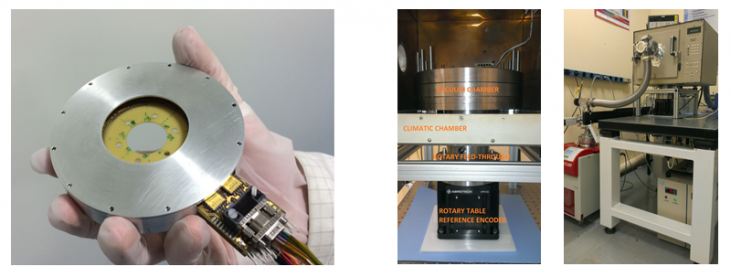
-
StatusCompleted
-
Status date2019-07-09
-
Activity Code4E.044
The ARTES 5.1 project entitled Contactless Angular Sensors for Telecom Satellites Long Lifetime Mechanisms (ESTEC CONTRACT NO. AO/1-5373/07/NL/IA), studied the technological solutions available in the market for the potential implementation of a contact-less angular sensor for European telecommunication satellite applications, identifying the past problems with rotary sensors, the demanded industry specifications and the expected market for close to medium future applications.
This ARTES 5.2 project represents a further step by proposing the implementation of an Engineering Model of the contactless angular sensor breadboard developed in the previous project, effectively increasing its TRL and approaching future flight model implementations. Starting from identified specifications, the project covers all the aspects for the contactless angular sensor EM manufacturing and testing, including redesign, reliability studies, full implementation of the EM and complete testing campaign.

There is a need, within the space sector, of a medium-high (10 to 20 bits) resolution fully qualified rotary sensors suitable for low cost off-the-shelf solutions for SADM or antennas drive mechanisms and versatile enough to provide custom solutions or developments if needed. The sensor should be easily and reliably integrated with customer electronics and provide its data through a serial bus.
In the development phase of this product we have maintained several contacts with interested customers that need a medium high resolution (10 to 20 bits) space qualified angular position sensor for space applications. Our proposed solution is considered not only to replace both potentiometers due to the intrinsic non-degradation mechanisms but also to provide an alternative to the very expensive optical technologies in current development.
Further, there is a need for a test-bench for testing medium-resolution angular sensor in relevant space environment, a key point that has been solved within the project.
EMXYS angular contactless sensor introduces an alternative to traditional potentiometer and optical sensors approach for angle measurement and feedback with no compromise of resolution of accuracy at extreme temperature and radiation environments.
The main characteristics of the sensor are:
- Absolute angle encoding with no mechanical contact. Possibility of sensing linear displacements.
- Adaptable to any outer and inner shaft diameter. Accuracies from 12-bits (0,1º) up to potentially 19-bits (0,001º) with diameters from 50mm to 150mm and widths of only 15mm.
- Full electrical redundancy and single point failure free electronics with two independent measurement circuits. Non-redundant mechanical interface.
- Flexible digital interface in parallel or serial form. Analog (2-wire) interface available.
- Single supply and very low power consumption. Extended temperature ranges and operation in radiation environments.
- Qualified electronics and materials for space, military or aeronautical applications.
- FPGA based conditioning electronics.
- Developed for the Telecommunications Space industry under ESA contract.
- RS485 serial communication. CAN or LVDS interfaces available upon request.
The project has developed as well a custom test-bench able to characterize the behaviour of the sensor in vacuum and temperature cycles and has complemented these tests with vibration and electromagnetic compatibility tests.
SYSTEM ARCHITECTURE
The sensor is based on the electrical coupling of two stators with a rotor in between that, by changing the dielectric constant of the stator plates, defines the angle of it. The measurement principle is based on nulling the electric currents that flow between the rotors with a feedback loop and therefore inherits the characteristics of negative feedback, such as immunity to external perturbations.
The implemented test-bench has several setups to simulate the space environment. In the validation setup, accuracy measurements can be performed while executing thermal vacuum cycling and mechanical tests.
An EM has been built and tested with the developed test-bench. The next expected milestone is, after having analysed the obtained results, to adapt the sensor for a flight unit.
A full implementation of a capacitively coupled angular sensor has been designed and manufactured, followed by an exhaustive test campaign. The sensor has not fulfilled all the specifications, the angular sensor EM showed an accuracy of 0.1 degree in contrast to the desired 0.01 degrees. Nevertheless, after carefully studying the results, design modifications have been identified that are expected to improve the performance of the sensor to be compliant to the specifications. This design update is planned for the next development activity.




